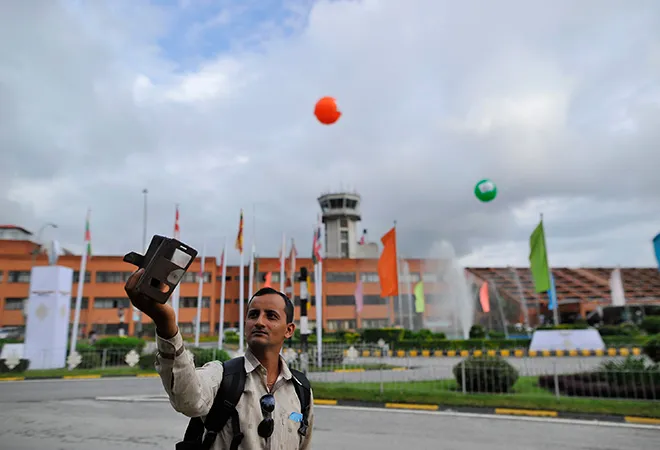
This article is part of the series — BIMSTEC in 2021.
The Bay of Bengal Initiative for Multi-Sectoral Technical and Economic Cooperation (BIMSTEC) that came into being on 6 June 1997, was joined by Nepal in 2004 as a member state. A sub-regional organisation with seven South and Southeast Asian countries, it has an aim to create an enabling environment for rapid economic development; to accelerate social progress; and to promote collaboration on matters of common interest in the Bay of Bengal. In 2004, the members decided to hold the Summit every two years as far as possible, and four Summits have been held — in 2004, 2008, 2014 and 2018 — so far.
The question that arises is whether countries like Nepal, Bhutan and Sri Lanka will benefit if BIMSTEC is under the shadow of ASEAN and pro-ASEAN members.
Generally, “regionalism” as a concept developed because an individual country’s efforts are never enough to meet challenges within and outside national borders. The recent awakening of Asian countries to assert Asia as a unit of unique civilisation may help BIMSTEC-like organisations to flourish. However, BIMSTEC has not really offered a very positive ray of hope as it has not even held its regular high level submits. The initiative had taken a step forward with its Goa summit in 2014, but it took four years to hold another summit. The BIMSTEC established its Permanent Secretariat only after 17 years. Rana<1> rightly states some of the weaknesses of BIMSTEC, i.e., ‘a great amount of flexibility in the conduct of its process’ without having a proper Charter and vision documents. It is often said that BIMSTEC has a leadership problem as well. Speculations are that the major stakeholders, namely India, Thailand and Myanmar, may talk about BIMSTEC but they have not been enthusiastically engaged to strengthen its initiatives. Rather, they favour a closer bond with ASEAN (Association of Southeast Asian Nations). India’s participation in dozens of partnership mechanisms of India-ASEAN cooperation with its Act East Policy, indicates that ASEAN is its priority today. Even Bangladesh, where the BIMSTEC Secretariat is located, tilts towards ASEAN because of its economic interest to expand its export market in the region. The question that arises is whether countries like Nepal, Bhutan and Sri Lanka will benefit if BIMSTEC is under the shadow of ASEAN and pro-ASEAN members.
Also, a majority of the BIMSTEC member countries are members of another regional cooperation — the South Asian Association for Regional Cooperation (SAARC). SAARC is in a coma after it couldn’t hold its regular summit, which was to be held in Pakistan in November 2016. It is the SAARC that has a very good organisational structure and many excellent study reports, decisions and declarations. Yet, it has been pushed to this comatose state despite the long commitment of the member states to make it a live and vibrant regional forum. It is said that all that is lacking in SAARC is proper implementation of its decisions and commitments. Unless the countries which are members of both SAARC and BIMSTEC identify and realise the causes behind the failure of the SAARC, a similar scenario is likely to be repeated by them with BIMSTEC as well.
SAARC has been pushed to a comatose state despite the long commitment of the member states to make it a live and vibrant regional forum.
According to Riva Ganguly Das, a well-established transport network is a prerequisite to reap the benefits of a free trade area, promote trade and investment, and enhance cooperation in areas such as tourism, people-to-people contact and cultural exchanges. She was referring to the Master Plan with a 10-year strategy and action plan document that was supposed to have started implementation in 2018 and be completed in 2028. But the draft was circulated only in October 2020 to be discussed and finalised, essentially meaning it has already lost two years and any further delay may affect the relevance of the Master Plan itself. As all members of BIMSTEC barring two are coastal states — Nepal and Bhutan are landlocked — the main priority of the regional grouping was on physical connectivity to facilitate human and state activities. Also, the concept of the “mountain economy” was brought to the discussion table by the ministerial meetings held in August 2017 in Kathmandu. It was a good initiative to integrate the mountain regions of India (including Uttarakhand, Himachal Pradesh and Northeast India) with Bhutan, Nepal and parts of Myanmar.
The challenges discussed above seems to have been acknowledged by the fourth Summit held in Kathmandu in 2018. The summit expressed commitment to making BIMSTEC a dynamic, more effective and result-oriented organisation. It also decided to establish a BIMSTEC Permanent Working Committee (BPWC) to deal with administrative and financial matters of the Secretariat. It also designated tasks, i.e., to prepare a preliminary draft of the Charter for the organisation defining a long-term vision and priorities for cooperation, to develop the Rules of Procedure (RoP) for BIMSTEC Mechanisms, and to explore the possibility of establishing a BIMSTEC Development Fund (BDF). Countries like Nepal agreed to be part of such sub-regional cooperation groups with the objective of connecting it to sea routes, mainly with the aim of making transportation easier. That is why Nepal has taken up certain responsibilities like holding the meeting related to Grid Interconnection, and conducting poverty alleviation activities.
The latest agreement to assign the Expert Group on BIMSTEC Visa Matters to continue negotiation for finalisation of the modalities for the BIMSTEC Visa Facilitation can be considered as an important step forward.
To conclude, the big challenge before BIMSTEC is to muster public support for the regional forum as people are not very optimistic about the idea of regional integration considering the failure of SAARC to deliver on its promises. Those who are already members of SAARC, with special visa agreements for their nationals within the region, have to also achieve similar visa facilities within the BIMSTEC member states. The latest agreement to assign the Expert Group on BIMSTEC Visa Matters to continue negotiation for finalisation of the modalities for the BIMSTEC Visa Facilitation can be considered as an important step forward. Members have to clarify what additional benefit they offer to the people, including those of the landlocked Member States. How can the people of Nepal and Bhutan benefit from inland fisheries, as the Nepalese and Bhutanese don’t have access to the sea? Unless the member states think of initiatives to engage with the common man to strengthen people-to-people relations within the region, the agenda of regional integration under BIMSTEC will also be an incomplete dream.
<1> Madhukar S.J.B. Rana, BIMSTEC: The Way Forward. In Indra Adhikari (ed.) Nepal in BIMSTEC and SAARC. Kathmandu: Institute of Foreign Affairs, 2018.
The views expressed above belong to the author(s). ORF research and analyses now available on Telegram! Click here to access our curated content — blogs, longforms and interviews.




 PREV
PREV


